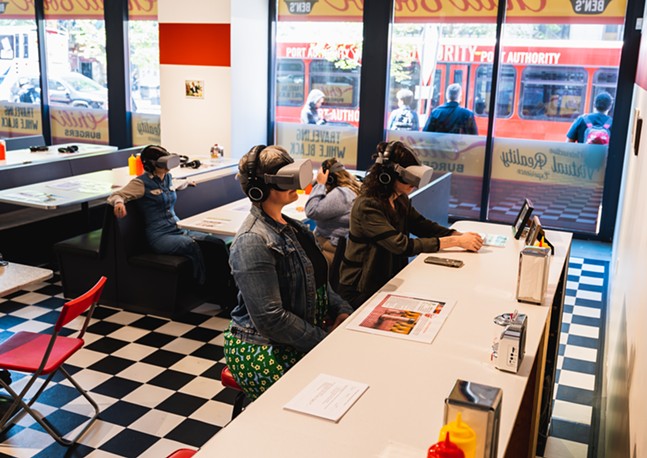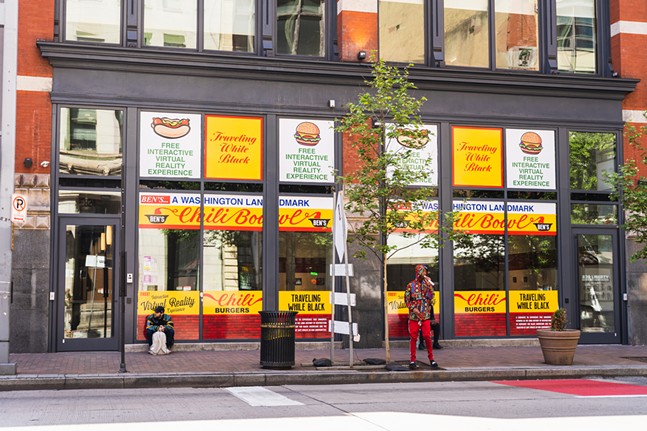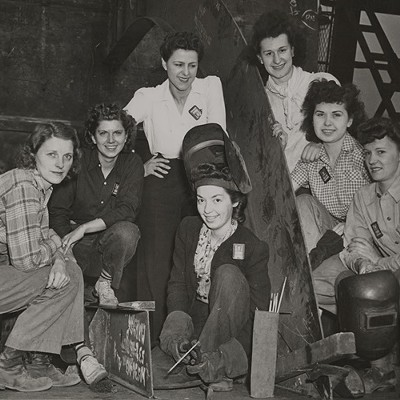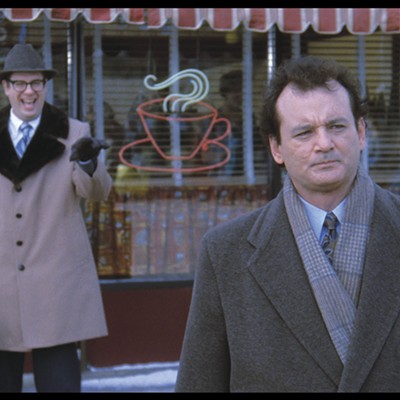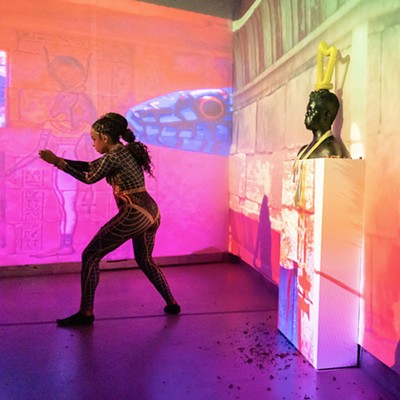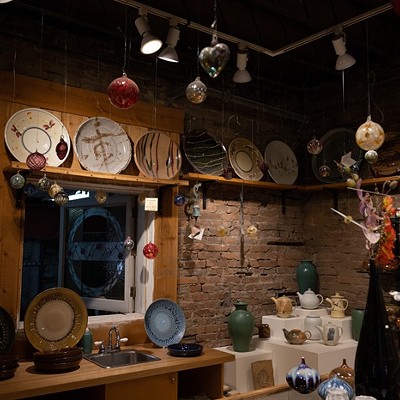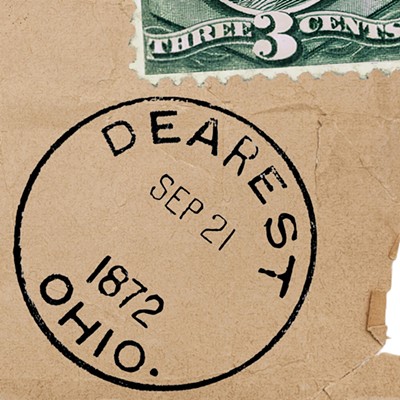Outside, the 820 Gallery looks like any Downtown art space, its exterior currently festooned in bright, eye-catching yellows and reds that call attention to a new exhibition. Inside, however, visitors won’t find perfectly placed paintings or sculptures, but a diner setting complete with booths. Oculus GO virtual reality headsets sit waiting to, as the Pittsburgh Cultural Trust website puts it, immerse visitors in the “long history of restriction of movement” for Black Americans, and their efforts to create safe spaces.
Called Traveling While Black, the exhibit, produced by Academy Award-winning documentary filmmaker Roger Ross Williams and Felix & Paul Studios, transports guests to Ben's Chili Bowl, a historic, Black-owned restaurant that has operated in Washington, D.C. for over 65 years. It has long served as a haven for Black Americans in times when they were prohibited from entering many businesses, and when traversing the country presented many challenges.
Traveling While Black, on view through Sept. 24, is one of three total local exhibitions depicting the Black experience in regards to travel, all in an effort to demonstrate how access to car ownership and the ability to move freely opened up more opportunities for Black communities, as well as made them more vulnerable to racist hostility. The other two, Pittsburgh and the Great Migration: Black Mobility and the Automobile at The Frick Pittsburgh Car and Carriage Museum and The Negro Motorist Green Book at Heinz History Center, complete a comprehensive trifecta that puts the history of Black travel in both a local and national perspective.
Dawn Brean, The Frick Pittsburgh’s chief curator and director of collections, tells Pittsburgh City Paper that her organization and Heinz History Center planned for their respective shows to coincide with each other. Pittsburgh and the Great Migration opened on May 6, followed by The Negro Motorist Green Book on May 13.
Traveling While Black was produced independently.
Brean says Pittsburgh and the Great Migration, on view through Feb. 4, 2024, examines the role of the automobile during the Great Migration, wherein, between 1910 and 1970, approximately six million Black people left the American South for cities in other regions of the country.
“There's a great history with the Great Migration and Black Southerners moving into Pittsburgh in pursuit of new economic opportunities,” says Brean.
Besides better financial prospects, the exodus was motivated by the need to escape racial violence and oppressive Jim Crow laws, which legalized segregation and denied jobs, education, and voting rights to Black Southerners.
Brean adds that the show covers how the Great Migration shaped the city, specifically the Hill District, a “vibrant, community and neighborhood” where, unfortunately, many of the cultural landmarks from the time period “don't exist anymore.”
Included in the show are 10 vehicles, two from the Frick Pittsburgh’s permanent collection, and eight on loan. Visitors can see an original 1914 Ford Model T and a 1939 Buick Model 61 Century Touring Sedan, as well as vehicles related to Pittsburgh. A 1941 Pontiac Super Streamliner Torpedo Six Sedan represents the type of car used by the Black-owned Owl Cab Company, a jitney service that operated in the Hill District. One car, a bright-red 1938 Packard Twelve convertible, is similar to one owned by Gus Greenlee, a major force in professional Black baseball at the time.
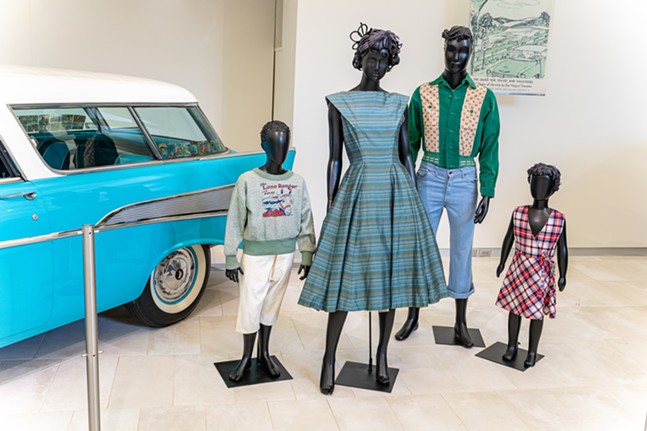
The show also includes period clothing, archival images, and other assets “evoking the drivers and passengers that were in these cars every day.”
“The invention of the automobile makes that freedom of movement accessible to more and more people,” Brean explains. “For those who could afford it, it made the journey that much easier, if you could escape the indignities of public transportation by rail or bus or what have you. You want to own your own vehicle and control your own travel. But there were also new dangers.”
Samuel W. Black, director of the African American Program at the Heinz History Center, speaks to some of the risks Black Americans faced when traveling across the U.S. throughout the 20th century. He adds that while automobiles were viewed as a “symbol of freedom,” Black travelers still had to “drive in hostile territory, which could be anywhere.”
The Center illustrates this with The Negro Motorist Green Book, which focuses on a national travel directory published between 1936 and 1966 by Victor Hugo Green. The publication listed hotels, restaurants, gas stations, and other businesses deemed safe for Black patrons, including in Pittsburgh.
“It was published at a time when, sadly, it was needed because of the discrimination and oppression, and African Americans were facing the difficulty in their mobility across the country,” Black says. “The reliance on public transportation like the rail lines, buses, and so forth really exposed them to segregation and discrimination in the country.”
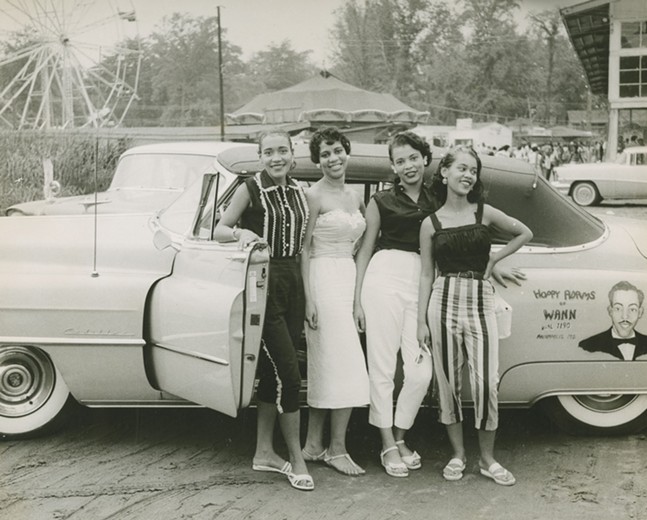
Beyond travel, Black says the guide also became “a tremendous resource for African Americans” because it “taught them about Black life in other parts of the country.”
Black says that while the touring exhibition comes courtesy of the Smithsonian Institution — of which Heinz History Center is an affiliate — local content was added to “bring the story home to Pittsburgh.” That “local content” includes artifacts from former Hill District locations listed in the Green Book, including the Terrace Hall Hotel and Harlem Casino Dance Hall, as well as a 1960s-era sign from the Centre Avenue YMCA.
Black says that, in the over five decades since the Green Book stopped publishing, it has become a source of nostalgia for many, with some surviving copies being auctioned off as collector's items (a 1958 edition was sold for $27,500 in 2019). Even so, visitors to the exhibition have memories of the book and the circumstances surrounding it. Black recalls one woman who told him how, as a young girl, her family would “always stop at the same gas station that had a restaurant” during trips.
“And they would fill up on gas, and they would eat, and they would use the bathroom,” he continues. “And whether you had to use it or not, you had to go to the bathroom.”
The woman said her brother once skipped this scheduled bathroom break. When nature called later on, her father refused to stop and, instead, handed the boy a bottle in which to relieve himself.
“The father was really angry,” Black says. “And the [woman] who's telling me the story, she never understood why the dad was so mad. … And I said, your father wasn’t angry that the boy had to use the bathroom — he was angry because it's a dangerous proposition now. It was probably a good 100 miles before you all could stop again, safely. You can't pull over on the side of the road. So now, the little boy having to use the bathroom is exposing the family to the horrors of America. That's what the father was angry about. She said, ‘I never understood that till I walked into this exhibit.’”
While Black Americans traveled to and lived in Pittsburgh, the city was, as Brean points out, not exactly ideal. Great Migration settlers would go on to work in steel mills, railroads, and other industries built by powerful tycoons like Frick Pittsburgh’s namesake, Henry Clay Frick, and his family, who profited off the labor of exploited workers. Often, Black workers were relegated to the most dangerous, lowest paying jobs.
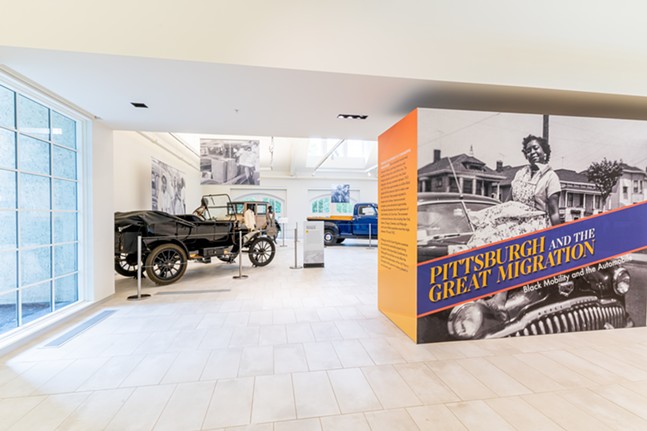
“What most Americans experience is extremely different than the Frick family's lived experience through the late-19th and early-20th centuries,” she says. “So we want to acknowledge the stories of other Americans, people that are more accessible to us, that are a more recognizable part of American history than this extremely wealthy white family. We talk about the workers that are making their wealth possible.”
As a result, Pittsburgh and the Great Migration serves as a reminder of how Black Americans had to make the best of the few options afforded to them, and grapples with the city’s own history.
“I feel like it's a must-see new show for anyone who is really interested in Pittsburgh history,” says Brean. “While there's a lot of pride in this period, I think we can also examine ways in which we might have failed these communities after the migration.”
Traveling While Black. Continues through Sept. 24. 820 Gallery. 820 Liberty Ave., Downtown. Free. trustarts.org
The Negro Motorist Green Book. Continues through Aug. 13. Heinz History Center. 1212 Smallman St., Strip District. Included with regular admission. heinzhistorycenter.org
Pittsburgh and the Great Migration: Black Mobility and the Automobile. Continues through Feb. 4, 2024. The Frick Pittsburgh Car and Carriage Museum. 7227 Reynolds St., Point Breeze. $1-18, free for members and youth 17 and under. thefrickpittsburgh.org

